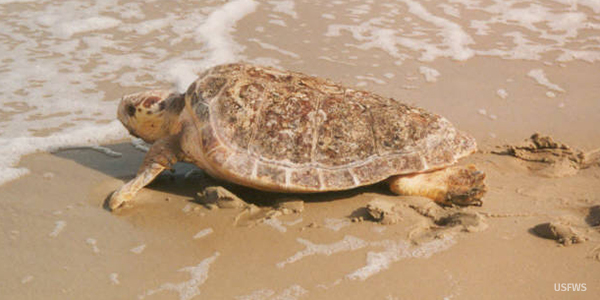
Distribution:
Found in the Atlantic, Pacific, and Indian
Oceans, as well as the Mediterranean Sea.
They inhabit tropical and temperate waters,
avoiding the coldest regions.
Ecosystem:
Primarily coastal habitats, including estuaries, bays,
lagoons, and coral reefs. They also frequent
open ocean areas, especially during migration
Feeding Habits:
Omnivorous with a preference for benthic invertebrates.
They feed on mollusks, crustaceans, fish, jellyfish,
and occasionally seaweed and algae.
Taxonomy:
Class: Reptilia
Family: Cheloniidae
Species: Caretta caretta
Overview and Physical Characteristics
Loggerhead turtles are highly recognizable by their large heads and powerful jaws, which aid in crushing hard-shelled prey. Adult loggerheads typically measure 3 feet (0.9 m) in length and can weigh between 200-375 pounds (90-170 kg). They have a heart-shaped reddish brown top shell and a yellow bottom shell. A male loggerhead turtle can be identified by its tail, which is longer than the female loggerhead’s tail.
Habitat and Distribution
Loggerhead turtles are the largest hard-shelled turtle, and the most abundant species of sea turtle that nests in the United States. They can be found in coastal habitats in temperate and subtropical regions of the Atlantic, Pacific, and Indian Oceans, as well as the Mediterranean Sea. Adult loggerheads prefer to live in bays, estuaries, and shallow coastal waters while juvenile and sub adult loggerheads tend to live in the open ocean. In the U.S. loggerhead turtles nest on beaches along the Atlantic coast from southern Virginia to the central Florida, as well as beaches on the Florida Gulf Coast as far as northward as Texas.
Ecosystem
Loggerheads are an essential part of maintaining the health of marine ecosystems. They feed on a variety of invertebrates and control their populations, which could otherwise overgraze seagrass beds and coral reefs. The shell of loggerhead turtles are their own small ecosystems, carrying colonies of small plants and animals on their shells. A single loggerhead turtle has been recorded with over 100 species of animals and plants living on its shell.
Feeding Habits
As omnivorous feeders, the loggerhead’s diet includes a wide range of prey. With their powerful jaws they can crush crab, conch, and clam shells. They also eat a variety of jellyfish, sponges, and plant material. They often forage sandy ocean bottoms, digging in the sand with their beaks to find buried prey. Their diverse diet enables them to thrive in various marine environments.
Behavior and Reproduction
Loggerhead turtles make long migrations between their feeding grounds and nesting sites. For instance, loggerhead turtles that nest in eastern Florida migrate into the Gulf Stream to North Atlantic waters as far away as the Azores (off the coast of Portugal), while loggerheads that forage along the West Coast of the U.S. were hatchlings that came from Japan. This strong homing instinct leads female to return to their original nesting sites every 2-3 years, where they will lay clutches of 100-120 eggs.
Visual System and Communication
Possessing excellent underwater vision that adapts both to bright light near the water’s surface as well as the dimmer lights of deeper depths, the loggerhead turtles have no problem locating prey. Not known for vocal communication, loggerheads use body language to interact with each other.
Fun Fact
To aid in their long migrations, loggerhead turtles can detect the Earth’s magnetic field and use it as a guide. It is thought that the young turtles are imprinted with the magnetic field of the nesting area where they are born, and use this information to assist them as adults, to lead them back from their far-flung migrations to the same beach at nesting time.
This story is part of the “Unleashing the Science” series, showcasing how bureaus within the Department of the Interior produce and apply science to ensure responsible management decisions for our planet now and for the future.
--BOEM--
The Department of the Interior’s Bureau of Ocean Energy Management (BOEM) manages development of U.S. Outer Continental Shelf (OCS) energy, mineral, and geological resources in an environmentally and economically responsible way.

